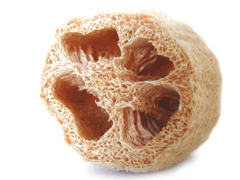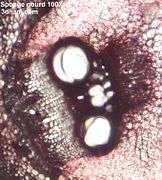Luffa
| Luffa | |
|---|---|
 | |
| Egyptian luffa with nearly mature fruit | |
| Scientific classification | |
| Kingdom: | Plantae |
| (unranked): | Angiosperms |
| (unranked): | Eudicots |
| (unranked): | Rosids |
| Order: | Cucurbitales |
| Family: | Cucurbitaceae |
| Subfamily: | Cucurbitoideae |
| Tribe: | Benincaseae |
| Subtribe: | Luffinae |
| Genus: | Luffa Mill.[1] |
| Species | |
| |
| Synonyms | |
Luffa is a genus of tropical and subtropical vines in the cucumber (Cucurbitaceae) family.
In everyday non-technical usage, the luffa, also spelled loofah, usually means the fruit of the two species L. aegyptiaca and L. acutangula. The fruit of these species is cultivated and eaten as a vegetable. The fruit must be harvested at a young stage of development to be edible. The vegetable is popular in China and Vietnam.[2] When the fruit is fully ripened, it is very fibrous. The fully developed fruit is the source of the loofah scrubbing sponge which is used in bathrooms and kitchens. Luffa are not frost-hardy, and require 150 to 200 warm days to mature.
The name luffa was taken by European botanists in the 17th century from the Egyptian Arabic name لوف lūf.[1]
Uses
Fiber
The fruit section of L. aegyptiaca may be allowed to mature and used as a bath or kitchen sponge after being processed to remove everything but the network of xylem fibers. If the loofah is allowed to fully ripen and then dry out on the vine, the flesh disappears leaving only the fibrous skeleton and seeds, which can be easily shaken out. Marketed as luffa or loofah, the sponge is used as a body scrub.
In Paraguay, panels are made out of luffa combined with other vegetable matter and recycled plastic. These can be used to create furniture and construct houses.[3]
Food
.jpg)
Luffa are best eaten when small (less than 12 cm) and still green.
In Vietnam, the gourd is called "mướp hương" and is a common ingredient in soups and stir-fried dishes.
In Tamil Nadu, the gourd is called Peerkangai and used as a vegetable to make Peerkangai kootu, poriyal, thogayal. Even the skin is used to make chutney.
In Karnataka's Malenadu (Western Ghats) it is known as tuppadahirekayi, which literally translates as "buttersquash". It grows naturally in this region and is consumed when it is still tender and green. It used as a vegetable in curries, but also as a snack, bhajji, dipped in chickpea batter and deep fried. Once the fruit dries out, it is used as a natural scrubber and washing sponge.
In Andhra Pradesh, it is called nethi beerakaya. And in Assam it is called zika (জিকা, Luffa acutangula) and bhûl (ভোল, Luffa aegyptica). It is used as a vegetable in a curry, chutney and stir fry.
In Kerala, it is called peechinga In Palakkad area it is particularly called poththanga and used in bath. It is used as a vegetable, cooked with dal or stir fried. Fully matured fruit is used as a natural scrub in rural Kerala. In some places like Wayanad, it grows as a creeper on fences.
In Maharashtra, India, dodka (ridge gourd luffa) and ghosavala (smooth luffa) are common vegetables prepared with either crushed dried peanuts or with beans.
In Manipur, India, Sebot is cooked with other ingredients like potato, dried fish, fermented fish and served. It is also steamed and consumed or crushed (Ironba) with other ingredients and served with steamed rice (Chaak). Fried ones (Kaanghou) are also favorites for many.
In Japan, it is called Hechima (へちま) and has been cultivated all over the country during summer. It is commonly used as a green vegetable in the traditional dishes of Nansei Islands and Kyushu while the other regions of Japan have been growing it predominantly to make sponge, soap, shampoo and lotion. Together with bitter melon, it is also a popular plant to grow outside of a building window during summer, in order to create natural shades to block out the direct sunlight and reduces the amount of heat radiating into a building.
In China, Indonesia (where it is called Sigua or oyong), the Philippines (where it is called patola) and Manipur, India, (where it is called sebot) the luffa is eaten as a green vegetable in various dishes. It is also known as "Chinese okra" in Canada. In Spanish, it is called an estropajo.
In Korea (where it is called Susemi), this plant is used washing dishes(loffah) and korean cusine.[4]
Luffa species are used as food plants by the larvae of some Lepidoptera species, including Hypercompe albicornis. In Myanmar, (where it is called tha-boot-thee သပြတ္သီး) probably derived from the word sebot in Manipur. When it is young used as food and when it is mature and dry, cleared of all seeds and used as sponge for cleaning purposes. It is also widely used in steaming glutinous rice instead of cloth.
Gallery
 A bag of dried mature luffa fruits.
A bag of dried mature luffa fruits. Luffa acutangula seeds. Each division of the ruler is 1 mm. Seeds of Luffa aegyptica look very similar.
Luffa acutangula seeds. Each division of the ruler is 1 mm. Seeds of Luffa aegyptica look very similar. A luffa sponge whose coarse texture helps with skin polishing.
A luffa sponge whose coarse texture helps with skin polishing. Luffa aegyptiaca sponge section magnified 100 times
Luffa aegyptiaca sponge section magnified 100 times Habitus of the vine
Habitus of the vine Luffa aegyptiaca - MHNT
Luffa aegyptiaca - MHNT Luffa operculata - MHNT
Luffa operculata - MHNT
See also
References
- 1 2 The plant name "Luffa" was introduced to Western botany nomenclature by the botanist Johann Vesling (died 1649), who visited Egypt in the late 1620s and described the plant under cultivation with artificial irrigation in Egypt. In 1706 the botanist Joseph Pitton de Tournefort introduced the formal botany genus name "Luffa". Tournefort referred to Veslingius's earlier description and reiterated that "Luffa Arabum" is a plant from Egypt in the cucumber family. In establishing the Luffa genus, Tournefort identified just one member species and called it "Luffa Arabum". His 1706 article includes detailed drawings of this species (which is now called Luffa aegyptiaca) – Ref. The species is native to tropical Asia but has been under cultivation in Egypt since late medieval times. The botanist Peter Forsskål visited Egypt in the early 1760s and noted that it was called لوف lūf in Arabic – Ref. In the 18th century the botanist Linnaeus adopted the name luffa for this species but assigned it to the Momordica genus, and did not use a separate Luffa genus. More refs on Luffa in 18th century botany nomenclature: "A commentary on Loureiro's "Flora Cochinchinensis" ", by E.D. Merrill, year 1935, in Transactions of American Philosophical Society volume 24 part 2, page 377-378. Luffa @ ATILF and "Suite de l'Etablissement de Quelques Nouveaux Genres de Plantes", by J.P. de Tournefort (1706) in Mémoires de l'Academe Royale des Sciences année 1706.
- ↑ "Luffa aegyptiaca". Floridata.com. Retrieved September 15, 2013.
- ↑ rolexawards.com; Recyclable homes, Rolex Awards 2008
- ↑ Korean Plant Names Index(Korean)